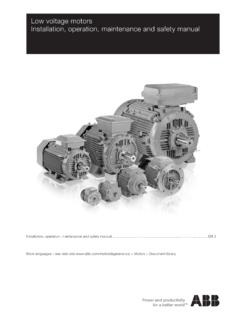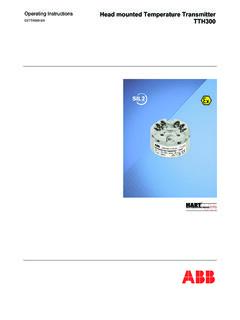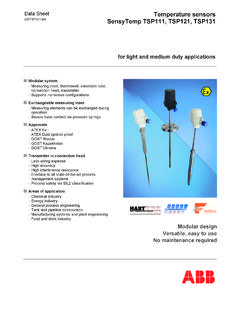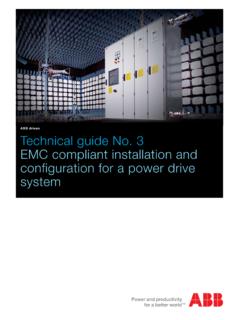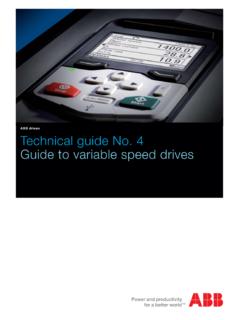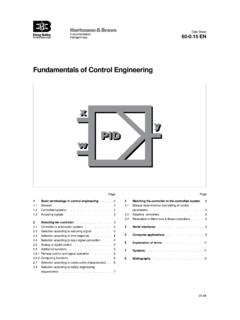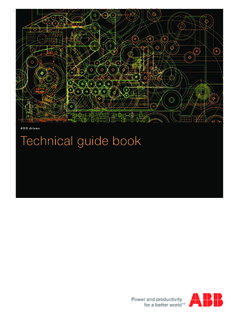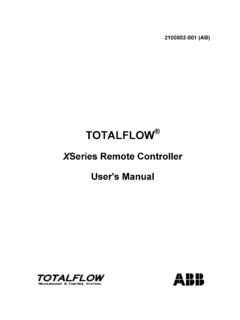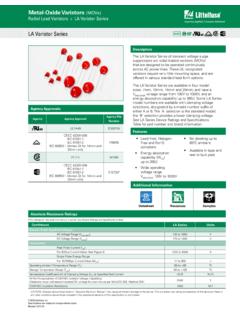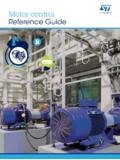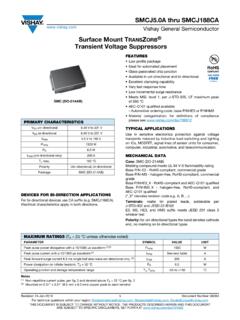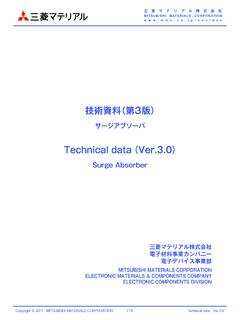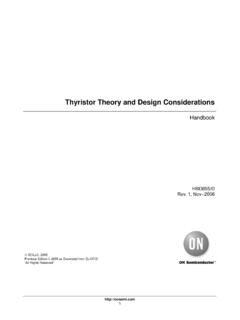Transcription of Transient Voltage Surge Suppressors - ABB
1 Transient Voltage Surge SuppressorsOVR SeriesLightning strike A lightning strike can have a destructive or disturbing effect on electrical installations situated up to several miles away from the actual point of the strike. During a storm, underground cables can transmit the effect of a lightning strike to electrical equipment installed inside buildings. A lightning protection device (such as a lightning rod or a Faraday cage) installed on a building to protect it against the risk of a direct strike (fire) can increase the risk of damage to electrical equipment connected to the main supply near or inside the lightning protection device diverts the high strike current to earth, considerably raising the potential of the ground close to the building on which it is installed. This causes overvoltages on the electrical equipment directly via the earth terminals and induced via the underground supply causes of Transient overvoltagesDirect strike on overhead lineDirect strike on overhead lineDirect strike on overhead lineIndirect lightning strike Indirect lightning strike Surge currentGroundingGround equipotentialityInduced overvoltageStrike on a lightning rodABB 1 Main causes of Transient overvoltagesContents:1.
2 Main causes of Transient overvoltages3. The solution: ABB OVR Transient Voltage Surge suppressor Series5. Selection / Application8. Feature / Benefits10. Installation Information11. OVR Series Part Number Breakdown12. Technical Data13. Part numbers / Pricing14. Application for Data ProductsSwitching operation on the power distribution systemThe switching of transformers, motors or inductances in general, sudden variation of load, disconnection of circuit breakers or cut outs ( in the distribution circuits) lead to overvoltages that penetrate the user s , the closer the building is to a generating station or sub station, the higher the overvoltages may is also necessary to take into account mutual induction effects between the high Voltage power line and aerial sections of the low voltages lines as well as direct contact between lines of different voltages caused by accidental breaking of interferencesThese are freak interferences with indifferent amplitudes and frequencies that are re-injected into the electrical supply by the user himself or his parasites can, for example, be due to.
3 Light fittings with discharge lamps Arc furnaces Welding equipment Thyristors operation Contactors operation Opening circuit breakers Starting a motor These interferences have little energy but their short duration, their steep wave front and their peak value (that can reach several kilovolts) can have harmful effects on the proper functioning of sensitive equipment causing either disruption or complete currentGroundingGround equipotentialityInduced overvoltageDisturbance generated by the userMV disturbance Transmitted to LVABB2 The solution: ABB OVR Transient Voltage Surge suppressor SeriesWhy is there a need for TVSS? Economical, service and security parameters: replacement and unavailability cost of the equipment to be protected, risk for the environment or for human life (petrochemical sites, stadium.)
4 Cost of repair Threat to human life - direct shock - security systems - magnetic locks - fire protection Protect sensitive electronicsSurge suppression is crucial to any power quality and power protection system, including lightning protection and three phases power systems. TVSS guard against Transient overvoltages, sometimes call transients, spikes or surges, hence the name Transient Voltage Surge suppressor or TVSS. Transients are known to damage sensitive electronic equipment in homes, schools, commercial, industrial, and medical facilities, wastewater treatment plants, factories, downtime, damage, and destruction caused to critical or electronic loads costs billions of dollars a is now the standard technology for increasing the reliability and uptime of 3 Main Panel boardSecondary Panel boardPhone LineGround equipotentialityWhere do we need TVSS?
5 Type I: Main AC power entrance protection The type I TVSS is designed to protect commercial and industrial facilities from the damaging affects of lightning. Power cables carry the damaging current into facilities. The device shunts these damaging currents safely to earth II: Distribution power Panel protectionThe type II TVSS is designed to protect all standard power Sub-distribution panel from damaging power line III: Branch circuit and equipment protectionTelecom / Data line protector: Protection of equipment connected onto telephone lines, computer, communication or data links, and current for multi-stage protectionSometimes it is not possible to find a device which provides both the required current capacity and protection level. In this case, the protection system has to have two or more stages, with a first device at the entrance of the installation ( as close as possible to the point of entrance of the lightning Surge ), which handles the current capacity, and a second device as close as possible to the protected equipment, which gives the required Voltage protection level.
6 The telecommunication lines entering the installation have to be protected as well; the grounding connections for all protections have to be equipotentially / ApplicationDetermination of the Voltage protection level ( Up )The Surge protective devices have to provide a level of protection compatible with the withstand Voltage of the equipment. This withstand Voltage depends on the type of equipment and its of the parameters Purpose the protectionProtective devices are used to prevent current surges from flowing through the network by diverting them harmlessly to the ground. They aiso limit overvoltages to values compatible with the withstand of the equipment or devices of the protectionIt can be easily understood from the above that the critical parameters of a Surge protective device are its ability to divert high values of current to the ground ( to dissipate large amount of energy) and to limit the Voltage to the lowest possible level.
7 Other parameters correspond to the fact that Surge protective devices have to be adapted to the network they are connected applicable international standards give a precise definition of these parameters: Maximum current lmax or limpThis is the maximum value of a Surge current that can be diverted by the Surge protective device; current surges with two different waveshapes are necessary to represent lightning currents: a long waveshape (10/350 s) which corresponds to a direct lightning strike and a short waveshape (8/20 s) which represents a damped indirect strike; lmax is the maximum value of a short waveshape current and limp is the value of a long waveshape current; the value lmax or limp has to be adapted to the expected value of the possible lightning currents. Voltage protection level Up The Voltage given by the Surge protective device, while diverting the Surge current to the ground Up, must not exceed the Voltage withstand value of the equipment connected downstream.
8 Maximum operating Voltage Uc The value of Voltage that the Surge protective device can be permanently connected to has to take into account the network nominal Voltage Un plus the possible ( s)i (A) maxIimp1020406080100 Wave 8/20 sWave 10/35 sElectrotechnical equipmentRequired protection levelUp 1, 8 to kVElectrotechnical equipment containing slightly sensitive electronicsRequired protection levelUp to kVSensitive electronic equipmentRequired protection levelUp 1 to kVHighly sensitive equipmentRequired protection levelUp to 1 kVABB 5 Selection/Application Identification of the networkThe type of product (single pole or multi pole) and the connection depend on the network, as follows:1 - phase networks3 - phase networks120 Volt Single Phase 2 Wire plus GroundSingle pole- OVRxx150x- OVR65 NPMulti pole- OVRxx150xTVSSTVSS240/120 Volt Single Phase 3 Wire plus Ground (split phase)Single pole- OVRxx150x- OVR65 NPMulti pole- OVRxx150xTVSSTVSS240 Volt, 480 Volt, 600 Volt Three Phase Delta 3 Wire plus GroundSingle pole- OVRxx275x- OVRxx550x- OVRxx660xMulti pole- OVRxx275x- OVRxx550x- OVRxx660xTVSSTVSS208Y/120 Volt, 480Y/277 Volt, 600Y/347 Volt Three Phase Wye 4 Wire plus GroundSingle pole- OVRxx150x- OVRxx320x- OVRxx440x- OVR65 NPMulti pole- OVRxx150x- OVRxx320x- OVRxx440xTVSSTVSS240/120 Volt Three Phase HLD (High Leg Delta)
9 4 Wire plus GroundSingle pole- OVRxx150x- OVR65 NPMulti pole- OVRxx150xTVSSTVSSABB6 Selection / ApplicationType of protector Main featuresType 1 TVSS according to EN 61643-11 - high energy capability to handle direct lightning strike (= Class I TVSS according to IEC 61643-1) - Surge current, Iimp = 15 kA (10/350 wave) - low protection level (Up = kV) - single and multi pole versions - easy maintenance thanks to pluggable modules - safety reserve(s) - remote indicator (TS)Type 2 TVSS according to EN 61643-11 - high energy capacity (up to 100 kA 8/20)(= Class II TVSS according to IEC 61643-1) - single and multi-pole versions - adapted to all types of networks - adapted to all network voltages (120 to 600 V) - single block and pluggable versions - local status indicator on front side - possible remote indicator (integrated in the product or with optical monitoring kit) - possibility of Safety reserveType 3 TVSS according to EN 61643-11 - low protection level (Up = kV)(= Class III TVSS according to IEC 61643-1) - local status indicator on front side - possible remote indicator with optical monitoring kit - adapted to all types of 230/400 V networks - multi-pole versionsTelecom and dataline protectors.
10 - compact design ( mm width)adapted to analog and digital transmission lines - local status indicator on front side - possible remote indicator with optical monitoring kitABB 7single pole multi polesingle pole multi poleFeature / BenefitsSingle block productsAll models include a mechanical indicator showing the arrester status. Some models feature a safety reserve function allowing preventive maintenance (the indicator will go into the reserve position first). Replacing the arrester is recommended; however protection is still productsThe pluggability is the main advantage of this range of Surge protective devices, because their replacement is very easy (no tools needed) due to a system of cartridges with pins pluggable TVSS may be delivered with the safety reserve(s) system of and/or an integrated contact (TS) for the remote are two connection possibilities, wired or with optical beamThe safety reserve allows preventive maintenance of the Surge protective indication (TS)The contact TS allows remote control of the status of the protection.
